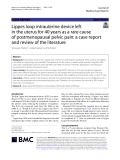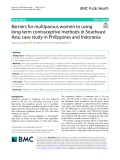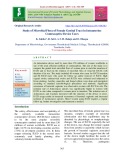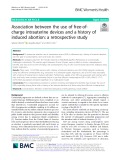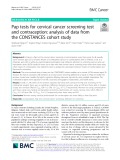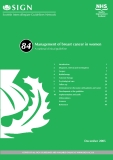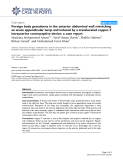
Intrauterine contraceptive device
-
Intrauterine devices are a widely used method of contraception worldwide. These devices are reliable, cost-effective, long-acting, and reversible. Their placement in the uterus is usually simple and safe. Forgotten IUDs carry some complications and can adversely affect the health of women. Therefore, appropriate counseling during insertion and timely removal are crucial.
 3p
3p  vitiki
vitiki
 30-01-2024
30-01-2024
 3
3
 2
2
 Download
Download
-
Multiparous women are supposed to be able to end their reproductive cycle to decrease population growth. This study aimed to analyze barriers for multiparous women to use long-term contraceptive methods (LTCM) in the Philippines and Indonesia.
 8p
8p  viferrari
viferrari
 28-11-2022
28-11-2022
 14
14
 2
2
 Download
Download
-
An intrauterine device used by more than 150 millions of women worldwide is one of the most efficient methods of contraception. The aim of the study is to compare the genital tract microbial flora of women prior to and after insertion of IUCD and to find out the relation of microbial flora of removed IUCDs with duration of its use. The study included 40 women who came for IUCD insertion and 80 IUCD users who came for follow up and/or removal of IUCD. High vaginal swabs, endocervical swabs and IUCDs were collected and subjected to Gram staining.
 7p
7p  trinhthamhodang1215
trinhthamhodang1215
 23-09-2020
23-09-2020
 14
14
 2
2
 Download
Download
-
To determine whether use of intrauterine device (IUD) is influenced by a history of induced abortion and the type of contraceptives used until costs are covered. Methods: We analyzed data from 301 female residents in Mecklenburg-West Pomerania, an economically challenged community.
 6p
6p  vitokyo2711
vitokyo2711
 31-08-2020
31-08-2020
 15
15
 2
2
 Download
Download
-
Despite its relatively low effectiveness, withdrawal is a common contraceptive practice. In Vietnam, health concerns about hormonal contraception are strong and account for substantial method discontinuation. Given the paucity of evidence on withdrawal, our objective was to identify correlates of using withdrawal among women not desiring pregnancy.
 7p
7p  vitokyo2711
vitokyo2711
 31-08-2020
31-08-2020
 20
20
 3
3
 Download
Download
-
Although intrauterine contraceptive device is highly effective, safe, long term and reversible method of contraception, the general population and physicians refuse. IUDs for nulliparous women due to persistent rumors about its side effects and complications.
 6p
6p  vitokyo2711
vitokyo2711
 31-08-2020
31-08-2020
 15
15
 3
3
 Download
Download
-
In France, a Pap test for cervical cancer screening is recommended every three years for all sexually active women aged 25 to 65 years. Modes of contraception (any or no contraception, with or without a visit to a physician, and with or without a gynecological examination) may influence adhesion to screening: women who use intrauterine device (IUD) should be more up to date with their cervical cancer screening more often than those using other means of contraception.
 13p
13p  viputrajaya2711
viputrajaya2711
 22-06-2020
22-06-2020
 17
17
 1
1
 Download
Download
-
Using an intrauterine contraceptive device is a highly effective and reliable method of contraceptive. It has been widely applied in the world due to its high efficiency, low risks and low cost. However, it may cause some important complications, one of these complications is migration of the intrauterine contraceptive device to adjacent organs into the abdomen cavity. We reported one case of female patients, 72 years old, who had an intrauterine contraceptive device for more than 30 years. 3-day onset of disease with bowel obstruction syndrome, abdominal pain, nausea and vomiting, no farting.
 5p
5p  caygaolon
caygaolon
 31-10-2019
31-10-2019
 15
15
 0
0
 Download
Download
-
Being pregnant is more dangerous than using con- traception. Therefore, the higher the typical failure rate (Table 1)1,2, the riskier a method is. This failure rate is 300 times as important in Afghanistan, Somalia, Sierra Leone or Niger(nearly 2% chance that a pregnancy will result in a maternal death and gener- ally no access to safe abortions) than in Scandinavia(0.007% chance, and induced abortions very safe).
 23p
23p  thaodien102
thaodien102
 06-11-2015
06-11-2015
 44
44
 3
3
 Download
Download
-
A double-freeze technique was used with two 3–minute periods of freezing separated by a 5–minute period to allow thawing of the frozen cervical tissue. Nitrous oxide (N2O) gas was used to achieve the freeze. Consistent with current MOH policy related to invasive gynecologic procedures such as intrauterine contraceptive device insertion, prophylactic antibiotics were provided at the time of the treatment. Those who complained of cramping, lower abdominal pain during or immediately after cryotherapy were given a prescription for several doses of an analgesic such as ibuprofen.
 52p
52p  taisaokhongthedung
taisaokhongthedung
 07-01-2013
07-01-2013
 40
40
 2
2
 Download
Download
-
As seen in Table 7, both Planned Parenthood and other WHP clinics typically offer a comprehensive range of contraceptive methods. The methods include oral contraceptives (the Pill) as well as long-acting reversible contraceptives (LARCs) such as intrauterine devices (IUDs), implants (e.g., Implanon), or injectables (e.g., Depo-Provera). LARCs are particularly important because they are the most effective in preventing unintended pregnancies and have lower failure rates.
 12p
12p  connicquy
connicquy
 20-12-2012
20-12-2012
 27
27
 4
4
 Download
Download
-
Contraceptive methods can be divided into two subgroups as hormonal and non-hormonal. Hormonal contraceptives include combined-oral contraceptives, progestin only pills, hormonal implants, progestin releasing intrauterine systems, depomedroxyprogesterone acetate injections, and vaginal rings. Non-hormonal contraceptive methods include male and female condoms, copper intrauterine device, tubal ligation and vasectomy of the companion. Combined oral contraceptives are a widely used and well accepted form of contraception.
 360p
360p  ti_du_hoang
ti_du_hoang
 15-08-2012
15-08-2012
 60
60
 9
9
 Download
Download
-
Tuyển tập báo cáo các nghiên cứu khoa học quốc tế ngành y học dành cho các bạn tham khảo đề tài: Foreign body granuloma in the anterior abdominal wall mimicking an acute appendicular lump and induced by a translocated copper-T intrauterine contraceptive device: a case report
 3p
3p  thulanh30
thulanh30
 19-12-2011
19-12-2011
 56
56
 2
2
 Download
Download
-
Intrauterine contraceptives are currently of two distinct types: • copper intrauterine devices (IUDs), in which the copper ion (the actual contraceptive) is released from a band or wire on a plastic carrier the levonorgestrel-releasing intrauterine system, which releases that progestogen – this will be abbreviated below as either LNG-IUS or just IUS.
 26p
26p  lananhanh123
lananhanh123
 27-08-2011
27-08-2011
 50
50
 2
2
 Download
Download
CHỦ ĐỀ BẠN MUỐN TÌM








